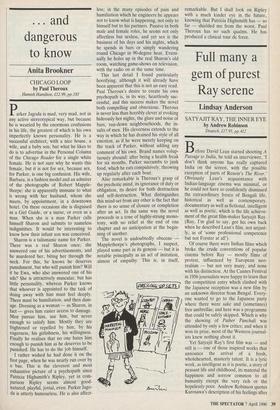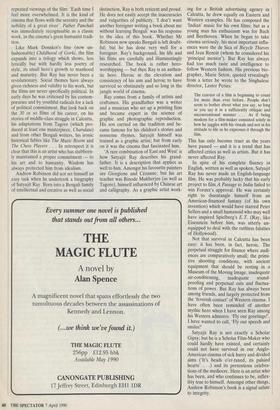Full many a gem of purest Ray serene
Lindsay Anderson
SATYAJIT RAY, THE INNER EYE by Andrew Robinson Deutsch, £17.95, pp.412 efore David Lean started shooting A
B
Passage to India, he told an interviewer, 'I don't think anyone has really captured India on the screen, with the possible exception of parts of Renoir's The River.' Obviously Lean's acquaintance with Indian-language cinema was minimal, or he could not have so confidently dismissed the extraordinary fresco of Bengali life, historical as well as contemporary, documentary as well as fictional, intelligent as well as poetic, which is the life achieve- ment of the great film-maker Satyajit Ray. (Ray, I'm glad to say, got his own back when he described Lean's film, not unjust- ly, as of 'some professional competence but not Forster at all').
Of course there were Indian films which broke the crude conventions of popular cinema before Ray — mostly films of protest, influenced by European neo- realism — but not very many, and none with his distinction. At the Cannes Festival in 1956 journalists were happy to learn that the competition entry which clashed with the Japanese reception was a new film by an unknown director from Bengal. Every- one wanted to go to the Japanese party where there were sake and (sometimes) free umbrellas; and here was a programme that could be safely skipped. Which is why the showing of Pather Panchali was attended by only a few critics; and when it won its prize, most of the Western journal- ists knew nothing about it.
Yet Satyajit Ray's first film was — and still is.— one of those inspired works that announce the arrival of a fresh, wholehearted, masterly talent. It is a lyric work, as intelligent as it is poetic, a story of peasant life and childhood, its material the happiness and sorrow common to all humanity except the very rich or the hopelessly poor. Andrew Robinson quotes Kurosawa's description of his feelings after repeated viewings of the film: `Each time I feel more overwhelmed. It is the kind of cinema that flows with the serenity and the nobility of a great river'. Pather Panchali was immediately recognisable as a classic work, in the cinema's great humanist tradi- tion.
Like Mark Donskoi's fine (now un- fashionable) Childhood of Gorki, the film expands into a trilogy which shows, less lyrically but with hardly less poetry of style, its small hero's growth to manhood and maturity. But Ray has never been a revolutionary. Social themes have always given richness and validity to his work, but the films are never specifically political. In early days he was criticised by his contem- poraries and by youthful radicals for a lack of political commitment. But look back on the 30 or so films of his career, on his stories of middle-class struggle in Calcutta, his adaptations from Tagore (which pro- duced at least one masterpiece, Charulata) and from other Bengali writers, his ironic historical fables like The Music Room and The Chess Players . . . In retrospect it is clear that this is an artist who has stubborn- ly maintained a proper commitment — to his art and to humanity. Wisdom has always protected him from idealism.
Andrew Robinson did not set himself an easy task when he undertook a biography of Satyajit Ray. Born into a Bengali family of intellectual and creative as well as social distinction, Ray is both reticent and proud. He does not easily accept the inaccuracies and vulgarities of publicity. 'I don't want another foreigner writing a book about me without learning Bengali' was his response to the idea of this book. Whether Mr Robinson now speaks Bengali is left doubt- ful; but he has done very well for a foreigner. Ray's background, his life and his films are carefully and illuminatingly researched. The book is rather hero- worshipping — but then Ray is an authen- tic hero. Heroic in the elevation and consistency of his aim and heroic to have survived so obstinately and so long in the jungle world of cinema.
Ray comes from a family of artists and craftsmen. His grandfather was a writer and a musician who set up a printing firm and became expert in the science of graphic and photographic reproduction. His son carried on the tradition and be- came famous for his children's stories and nonsense rhymes. Satyajit himself was trained as a graphic artist; but from early on it was the cinema that fascinated him.
`A rare combination of East and West' is how Satyajit Ray describes his grand- father. It is a description that applies as well to him. Amongst his favourite painters are Giorgione and Cezanne; but his art teacher was Binode Mukherjee (as well as Tagore), himself influenced by Chinese art and calligraphy. As a graphic artist work- ing for a British advertising agency in Calcutta, he drew equally on Eastern and Western examples. He has composed the `Indian' music for his own films; but as a young man his enthusiasm was for Bach and Beethoven. When he began to take cinema seriously, his most important influ- ences were the de Sica of Bicycle Thieves and Jean Renoir (whom he considered his `principal mentor'). But Ray has always had too much taste and intelligence to follow Western fashion. His previous bio- grapher, Marie Seton, quoted revealingly from a letter he wrote to the Singhalese director, Lester Peries: The exterior of a film is beginning to count for more than ever before. People don't seem to bother about what you say, so long as you say it in a sufficiently oblique and unconventional manner . . . As if being modern for a film-maker consisted solely in how he juggles with his visuals and not in his attitude to life as he expresses it through the film.
This has only become truer as the years have passed — and it is a trend that has affected critics as well as artists. But it has never affected Ray.
In spite of his complete fluency in English, written as well as spoken, Satyajit Ray has never made an English-language film. He was probably lucky that his early project to film A Passage to India failed to win Forster's approval. He was certainly right to disentangle himself from an American-financed fantasy (of his own invention) which would have starred Peter Sellers and a small humanoid who may well have inspired Spielberg's E. T. (Ray, like Eisenstein before him, was utterly un- equipped to deal with the ruthless falsities of Hollywood).
Not that survival in Calcutta has been easy: it has been, in fact, heroic. The perpetual struggle for finance where audi- ences are comparatively small; the primi- tive shooting conditions, with ancient equipment that should be resting in a Museum of the Moving Image, inadequate air-conditioning, inadequate sound- proofing and perpetual cuts and fluctua- tions of power. But Ray has always been among friends, and largely protected from the `feverish contact' of Western cinema. I have often been reminded of another mythic hero when I have seen Ray among his Western admirers. `Fly our greetings!', I have wanted to call, 'Fly our speech and smiles!'
Satyajit Ray is not exactly a Scholar Gipsy; but he is a Scholar Film-Maker who could liardly have existed, and certainly could not have survived in our Anglo- American cinema of sick hurry and divided aims (It's heads o'er-taxed, its palsied hearts' . . .) and its pretentious celebra- tions of the mediocre. Here is an artist who has been, and who continues to be, inflex- ibly true to himself. Amongst other things, Andrew Robinson's book is a signal salute to integrity.



























































 Previous page
Previous page